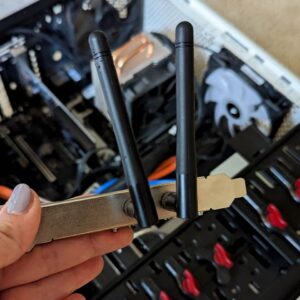Buying a new soundbar is one of the easiest ways to improve the sound quality in your gaming or TV setup. They're simple to install and even easier to use, look decent, and fit easily into most existing setups.
But how do you know which soundbar to choose? Should you choose a 5.1, 3.1, or 2.1 soundbar, and what's the difference between them?
What Do These Soundbar Numbers Mean?
When it comes to soundbar configurations, you might see a set of numbers, like 5.1, 3.1, or 2.1. While these numbers may look a little confusing, they're easy to understand.
The first number refers to the number of speakers (channels), and the second number refers to the subwoofer. So, a 5.1 soundbar configuration will include five speakers and one subwoofer, while a 3.1 soundbar configuration features three speakers and one subwoofer.

Now, in some speaker configurations, you'll see a third number, like 5.1.3. The third number indicates it includes "height" or "overhead" speakers, which basically expand the listening experience into a more comprehensive, 3D audio field.

But here's the thing with soundbars. Because of their shape and style, the number of speakers doesn't always represent what you see physically. Soundbars arrange their speakers along the length of the unit. So, while you may have a 5.1 soundbar, you might not always be positioning five physical speakers around the room.
Our detailed explainer on surround sound system configurations has much more information on speaker position, audio effects, and so on.
5.1 vs. 3.1 vs. 2.1 Soundbar: What's the Difference?
Now that you know what soundbar numbers mean, it's time to see how they affect your listening experience.
What Is a 2.1 Soundbar?
A 2.1 soundbar setup typically consists of two main speaker channels (i.e., two speakers) in the same unit and a subwoofer. You'll have a left and right channel in the soundbar, and the subwoofer will be a separate unit designed to produce low-frequency sounds.
Upgrading to a 2.1 soundbar will deliver better stereo audio separation and provide clearer, more distinct audio and likely better audio quality than any built-in speakers. However, most 2.1 soundbars will not provide an immersive surround sound experience (unless you have extra audio tech like Dolby Atmos or DTS:X—keep reading for more information!).
What Is a 3.1 Soundbar?
The 3.1 soundbar adds another speaker—or channel—to give you left, right, and center, along with the subwoofer. The extra speaker significantly improves the overall balance of your audio and makes vocals and other dialog clearer.
A soundbar of sufficient size will have three speakers. Upgrading from a 2.1 soundbar to a 3.1 soundbar is a useful upgrade for anyone who wants clearer dialog, especially given the issues of hearing spoken words in modern films and shows.
What Is a 5.1 Soundbar?
A 5.1 soundbar adds two more channels, giving you left, right, and center, plus two additional channels that provide a surround sound effect.
Switching from a 2.1 or 3.1 soundbar to a 5.1 soundbar delivers an enormous boost to overall sound quality, giving the closest to a full surround sound experience without positioning heaps of speakers around your room.
The uptick in audio quality with a 5.1 soundbar will deliver a fully immersive experience, and a sufficiently high-quality soundbar will create a proper mini-theater-style audio configuration.
In short, if you want a full audio experience, the channel separation in a 5.1 soundbar will provide the best audio for almost every type of media.
What About Dolby Atmos and DTS:X?
Soundbar audio is good. Great, even, depending on the soundbar you buy. But when you buy a soundbar, the number of speakers isn't all you should consider.
Dolby Atmos and DTS:X provide enhanced audio, significantly boosting the soundbar listening experience by adding a vertical audio dimension. Think back to the numbers in the soundbar speaker name: The first digit describes the channels, the second the subwoofer, and the third provides vertical audio.
But if you don't have those extra speakers, audio tech like Dolby Atmos and DTS:X provide virtual vertical audio, creating a full surround sound experience without the extra physical speakers.
- In a soundbar equipped with Dolby Atmos technology, integrated speakers project sound upwards. These sound waves reflect off the ceiling to the listener, creating the illusion of height and adding depth to the audio experience. This technology allows viewers to perceive distinct sounds—such as a helicopter flying overhead or raindrops falling around them—with remarkable clarity and realism.
- A soundbar equipped with DTS:X tech offers a similar immersive experience but is designed to be more flexible with speaker configurations and does not strictly require dedicated upward-firing speakers. It can adapt to the existing hardware to create a multi-dimensional audio environment, enabling soundbars without specific height channels to still deliver an engaging and dynamic sound experience.
So, when buying a 2.1, 3.1, or 5.1 soundbar, checking for Dolby Atmos or DTS:X support can make the difference between a good audio experience and a great one.
What 5.1, 3.1, or 2.1 Soundbar Should You Buy?
When buying a soundbar, it's key to note that the channel numbers might not always correlate to what's written here.
Samsung<\/a>"">
For example, the Samsung Q990C Q-Series (above) is one of the most highly-rated soundbars and features an incredible 11.1.4 configuration. That's 11 channels with four additional channels for complete surround sound, but you can expect to pay around $1,400 for the experience.
Sony<\/a>"">
What's really key is your budget. You can pick up a brilliant 3.1 soundbar, like the Sony HT-S2000 (above), for a few hundred bucks, and it'll give you an outstanding, atmospheric audio experience without breaking the bank. This budget-focused option delivers excellent sound across its three channels, and while it's not the best-looking soundbar, it's plenty decent for the price.
Denon<\/a>"">
But even cheaper still is something like the Denon DHT-S217 (above), an excellent 2.1 soundbar featuring Dolby Atmos. There aren't many cheaper 2.1 soundbars delivering good Dolby Atmos sound, and its stylish design and decent connectivity make it a great option.






